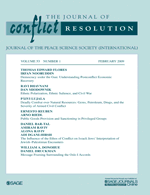This article examines the link between subnational poverty and the location of civil war events. Drawing on the ACLED dataset, which breaks internal conflicts down to individualevents at the local level, we take a disaggregated approach to the study of conflict. Local-level socioeconomic data are taken from the Liberian Demographic and Health Survey. With geographical cells of approximately 76 km2 as units of analysis, we test how absolute and relative welfare affect the presence and number of conflict events during the 1989-2002 Liberian civil war. We control for neighboring conflict events, distance to Monrovia and national borders, population density, diamond deposits, and ethnic affiliations. War events were more frequent in the richer locations. This may provide better support for “opportunity” explanations than for “relative deprivation” theories of conflict, but we argue that the relative weakness of the Liberian government makes it difficult to distinguish between the two.
Hegre, Håvard; Gudrun Østby & Clionadh Raleigh (2009) Poverty and Civil War Events: A Disaggregated Study of Liberia, Journal of Conflict Resolution 53 (4): 298–623.









